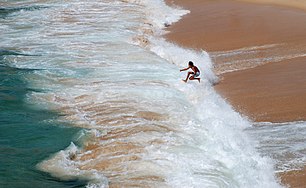Play (activity): Difference between revisions
| Line 15: | Line 15: | ||
==Forms of play== |
==Forms of play== |
||
[[File:July 4th Traditions (7188250241).jpg|thumbnail|People having fun]] |
[[File:July 4th Traditions (7188250241).jpg|thumbnail|People having fun]] |
||
Play can take the form of improvisation or pretence, interactive, performance, mimicry, games, sports, and thrill-seeking, such as extreme or dangerous sports (sky-diving, high-speed racing, etc.). Philosopher [[Roger Caillois]] wrote about play in his 1961 book ''[[Man, Play and Games]]'' and [[Stephen Nachmanovitch]] expanded on these concepts in his 1990 book ''Free Play: Improvisation in Life and Art''.<ref>Nachmanovitch, Stephen, ''Free Play: Improvisation in Life and Art''. Tarcher/Penguin 1990.</ref> Nachmanovitch writes that: |
Play can take the form of improvisation or pretence, interactive, performance, mimicry, [http://www.ahataxis.com/blog/5-fun-games-to-play-during-trips games], sports, and thrill-seeking, such as extreme or dangerous sports (sky-diving, high-speed racing, etc.). Philosopher [[Roger Caillois]] wrote about play in his 1961 book ''[[Man, Play and Games]]'' and [[Stephen Nachmanovitch]] expanded on these concepts in his 1990 book ''Free Play: Improvisation in Life and Art''.<ref>Nachmanovitch, Stephen, ''Free Play: Improvisation in Life and Art''. Tarcher/Penguin 1990.</ref> Nachmanovitch writes that: |
||
{{quote| Improvisation, composition, writing, painting, theater, invention, all creative acts are forms of play, the starting place of creativity in the human growth cycle, and one of the great primal life functions. Without play, learning and evolution are impossible. Play is the taproot from which original art springs; it is the raw stuff that the artist channels and organizes with all his learning and technique. (Free Play, p. 42) }} |
{{quote| Improvisation, composition, writing, painting, theater, invention, all creative acts are forms of play, the starting place of creativity in the human growth cycle, and one of the great primal life functions. Without play, learning and evolution are impossible. Play is the taproot from which original art springs; it is the raw stuff that the artist channels and organizes with all his learning and technique. (Free Play, p. 42) }} |
||
Revision as of 06:49, 6 July 2015
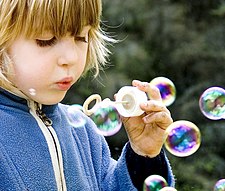
In psychology and ethology, play is a range of voluntary, intrinsically motivated activities normally associated with recreational pleasure and enjoyment.[1] Play is most commonly associated with children and their juvenile-level activities, but play can also be a useful adult activity, and occurs among other higher-functioning (non-human) animals as well.
Many of the most prominent researchers in the field of psychology (including Melanie Klein, Jean Piaget, William James, Sigmund Freud, Carl Jung and Lev Vygotsky) have viewed play as endemic to the human species. These psychologists all had strong beliefs on how important play was on human development. Many research methods were performed to prove their theories.
Play is often interpreted as frivolous; yet the player can be intently focused on their objective, particularly when play is structured and goal-oriented, as in a game. Accordingly, play can range from relaxed, free-spirited and spontaneous through frivolous to planned or even compulsive.[2] Play is not just a pastime activity; it has the potential to serve as an important tool in numerous aspects of daily life for adolescents, adults, and cognitively advanced non-human species (such as primates). Not only does play promote and aid in physical development (such as hand–eye coordination), but it also aids in cognitive development and social skills, and can even act as a stepping stone into the world of integration, which can be a very stressful process.
Definitions

The seminal text in the field of play studies is the book Homo Ludens first published in 1944 with several subsequent editions, in which Johan Huizinga defines play as follows:[2]: 13
"Summing up the formal characteristic of play, we might call it a free activity standing quite consciously outside 'ordinary' life as being 'not serious' but at the same time absorbing the player intensely and utterly. It is an activity connected with no material interest, and no profit can be gained by it. It proceeds within its own proper boundaries of time and space according to fixed rules and in an orderly manner. It promotes the formation of social groupings that tend to surround themselves with secrecy and to stress the difference from the common world by disguise or other means."
This definition of play as constituting a separate and independent sphere of human activity is sometimes referred to as the "magic circle" notion of play, a phrase also attributed to Huizinga.[2] Many other definitions exist. Jean Piaget stated, "the many theories of play expounded in the past are clear proof that the phenomenon is difficult to understand." [3] [page needed]
Forms of play
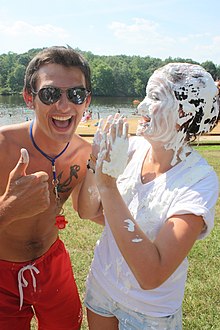
Play can take the form of improvisation or pretence, interactive, performance, mimicry, games, sports, and thrill-seeking, such as extreme or dangerous sports (sky-diving, high-speed racing, etc.). Philosopher Roger Caillois wrote about play in his 1961 book Man, Play and Games and Stephen Nachmanovitch expanded on these concepts in his 1990 book Free Play: Improvisation in Life and Art.[4] Nachmanovitch writes that:
Improvisation, composition, writing, painting, theater, invention, all creative acts are forms of play, the starting place of creativity in the human growth cycle, and one of the great primal life functions. Without play, learning and evolution are impossible. Play is the taproot from which original art springs; it is the raw stuff that the artist channels and organizes with all his learning and technique. (Free Play, p. 42)
Structured play has clearly defined goals and rules and such play is called a "game". Other play is unstructured or open-ended. Both types of play promote adaptive behaviors and mental states of happiness.[citation needed]
Often sports with defined rules will take place within designated play spaces, such as sports fields where, in Soccer for example, players kick a ball in a certain direction and push opponents out of their way as they do so. While appropriate within the sport's play space, these same behaviors might be inappropriate or even illegal outside the playfield.[2]
Other designed play spaces can be playgrounds with dedicated equipment and structures to promote active and social play. Some play spaces go even farther in specialization to bring the play indoors and will often charge admission as seen at Children's Museums, Science Centers, or Family Entertainment Centers. Family Entertainment Centers (or Play Zones) are typically For-Profit businesses purely for play and entertainment, while Children's Museums and Science Centers are typically Non-Profit organizations for educational entertainment.
The California based National Institute for Play describes seven play patterns:[5]
- Attunement play, which establishes a connection, such as between newborn and mother.
- Body play, in which an infant explores the ways in which his or her body works and interacts with the world, such as making funny sounds or discovering what happens in a fall.
- Object play, such as playing with toys, banging pots and pans, handling physical things in ways that use curiosity.
- Social play, play which involves others in activities such as tumbling, making faces, and building connections with another child or group of children.
- Imaginative or pretend play, in which a child invents scenarios from his or her imagination and acts within them as a form of play, such as princess or pirate play.
- Storytelling play, the play of learning and language that develops intellect, such as a parent reading aloud to a child, or a child retelling the story in his or her own words.
- Creative play, by which one plays with imagination to transcend what is known in the current state, to create a higher state. For example, a person might experiment to find a new way to use a musical instrument, thereby taking that form of music to a higher plane; or, as Einstein was known to do, a person might wonder about things which are not yet known and play with unproven ideas as a bridge to the discovery of new knowledge.
Separate from self-initiated play, play therapy is used as a clinical application of play aimed at treating children who suffer from trauma, emotional issues and other problems.[6]
Play and children
In young children, play is frequently associated with cognitive development and socialization. Play that promotes learning and recreation often incorporates toys, props, tools or other playmates. Play can consist of an amusing, pretend or imaginary activity alone or with another. Some forms of play are rehearsals or trials for later life events, such as "play fighting", pretend social encounters (such as parties with dolls), or flirting.[7] Modern findings in neuroscience suggest that play promotes flexibility of mind, including adaptive practices such as discovering multiple ways to achieve a desired result, or creative ways to improve or reorganize a given situation (Millar, 1967; Shonkoff & Phillips, 2000).[full citation needed]
As children get older, they engage in board games, video games and computer play, and in this context the word gameplay is used to describe the concept and theory of play and its relationship to rules and game design. In their book, Rules of Play, researchers Katie Salen and Eric Zimmerman outline 18 schemas for games, using them to define "play", "interaction" and "design" formally for behaviorists.[8] Similarly, in his book Half-Real: Video Games between Real Rules and Fictional Worlds, game researcher and theorist Jesper Juul explores the relationship between real rules and unreal scenarios in play, such as winning or losing a game in the real world when played together with real-world friends, but doing so by slaying a dragon in the fantasy world presented in the shared video game.[9]

Learning through play has been long recognized as a critical aspect of childhood and child development. Some of the earliest studies of play started in the 1890s with G. Stanley Hall, the father of the child study movement that sparked an interest in the developmental, mental and behavioral world of babies and children. Play also promotes healthy development of parent-child bonds, establishing social, emotional and cognitive developmental milestones that help them relate to others, manage stress, and learn resiliency.[10][11]
Modern research in the field of affective neuroscience (the neural mechanisms of emotion) has uncovered important links between role play and neurogenesis in the brain.[12] For example, researcher Roger Caillois used the word ilinx to describe the momentary disruption of perception that comes from forms of physical play that disorient the senses, especially balance.
In addition, evolutionary psychologists have begun to explore the phylogenetic relationship between higher intelligence in humans and its relationship to play, i.e., the relationship of play to the progress of whole evolutionary groups as opposed to the psychological implications of play to a specific individual.
Play is explicitly recognized in Article 31 of the Convention on the Rights of the Child (adopted by the General Assembly of the United Nations, November 29, 1989), which declares:
- Parties recognize the right of the child to rest and leisure, to engage in play and recreational activities appropriate to the age of the child and to participate freely in cultural life and the arts.
- Parties shall respect and promote the right of the child to participate fully in cultural and artistic life and shall encourage the provision of appropriate and equal opportunities for cultural, artistic, recreational and leisure activities.
History of childhood playtime

American historian Howard Chudacoff has studied the interplay between parental control of toys and games and children's drive for freedom to play. In the colonial era, toys were makeshift and children taught each other very simple games with little adult supervision. The market economy of the 19th century enabled the modern concept of childhood as a distinct, happy life stage. Factory-made dolls and doll houses delighted young girls. Organized sports filtered down from adults and colleges, and boys learned to play with a bat, a ball and an impromptu playing field. In the 20th century, teenagers were increasingly organized into club sports supervised and coached by adults, with swimming taught at summer camps and through supervised playgrounds.[13] Under the New Deal's Works Progress Administration, thousands of local playgrounds and ball fields opened, promoting softball especially as a sport for all ages and both sexes.[citation needed] By the 21st century, Chudacoff notes, the old tension between parental controls and a child’s individual freedom was being played out in cyberspace.[14]
Play and adults
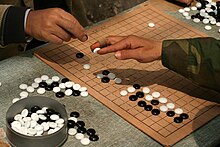
Although adults who engage in excessive amounts of play may find themselves described as "childish" or "young at heart" by less playful adults, play is actually an important activity, regardless of age. Creativity and happiness can result from adult play, where the objective can be more than fun alone, as in adult expression of the arts, or curiosity-driven science.[15] Some adult “hobbies” are examples of such creative play. In creative professions, such as design, playfulness can remove more serious attitudes (such as shame or embarrassment) that impede brainstorming or artistic experimentation in design.[15]
Imaginative play and role play may allow adult individuals to practice useful habits such as learned optimism, which is helpful in managing fear or terrors. Play also offers adults the opportunity to practice concepts that may not have been explicitly or formally taught (e.g. how to manage misinformation or deceit). Thus, even though play is just one of many tools used by effective adults, it remains a necessary one.[16]
Play and animals

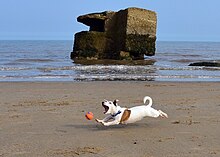
Evolutionary psychologists believe that there must be an important benefit of play, since there are so many reasons to avoid it. Animals are often injured during play, become distracted from predators, and expend valuable energy. In rare cases, play has even been observed between different species that are natural enemies such as a polar bear and a dog.[17] Yet play seems to be a normal activity with animals who occupy the higher strata of their own hierarchy of needs. Animals on the lower strata, e.g. stressed and starving animals, generally do not play.[16]
The social cognitive complexity of numerous species, including dogs, have recently been explored in experimental studies. In one such study, conducted by Alexandra Horowitz of the University of California, the communication and attention-getting skills of dogs were investigated. In a natural setting, dyadic play behavior was observed; head-direction and posture was specifically noted. When one of the two dogs was facing away or otherwise preoccupied, attention-getting behaviors and signals (nudging, barking, growling, pawing, jumping, etc.) were used by the other dog to communicate the intent and/or desire to continue on with the dyadic play. Stronger or more frequent signaling was used if the attention of the other dog was not captured. These observations tell us that these dogs know how play behavior and signaling can be used to capture attention, communicate intent and desire, and manipulate one another. This characteristic and skill, called the "attention-getting skill" has generally only been seen in humans, but is now being researched and seen in many different species.[18]
Observing play behavior in various species can tell us a lot about the player's environment (including the welfare of the animal), personal needs, social rank (if any), immediate relationships, and eligibility for mating. Play activity, often observed through action and signals, often serves as a tool for communication and expression. Through mimicry, chasing, biting, and touching, animals will often act out in ways so as to send messages to one another; whether it's an alert, initiation of play, or expressing intent. When play behavior was observed for a study in Tonkean Macaques, it was discovered that play signals weren't always used to initiate play; rather, these signals were viewed primarily as methods of communication (sharing information and attention-getting).[19]
One theory – "play as preparation" – was inspired by the observation that play often mimics adult themes of survival. Predators such as lions and bears play by chasing, pouncing, pawing, wrestling, and biting, as they learn to stalk and kill prey. Prey animals such as deer and zebras play by running and leaping as they acquire speed and agility. Hoofed mammals also practice kicking their hind legs to learn to ward off attacks. While mimicking adult behavior, attacking actions such as kicking and biting are not completely fulfilled, so playmates do not generally injure each other. In social animals, playing might also help to establish dominance rankings among the young to avoid conflicts as adults.[16]
John Byers, a zoologist at the University of Idaho, discovered that the amount of time spent at play for many mammals (e.g. rats and cats) peaks around puberty, and then drops off. This corresponds to the development of the cerebellum, suggesting that play is not so much about practicing exact behaviors, as much as building general connections in the brain. Sergio Pellis and colleagues at the University of Lethbridge in Alberta, Canada, discovered that play may shape the brain in other ways, too. Young mammals have an overabundance of brain cells in their cerebrum (the outer areas of the brain – part of what distinguishes mammals). There is evidence that play helps the brain clean up this excess of cells, resulting in a more efficient cerebrum at maturity.[16]
Marc Bekoff (a University of Colorado evolutionary biologist) proposes a "flexibility" hypothesis that attempts to incorporate these newer neurological findings. It argues that play helps animals learn to switch and improvise all behaviors more effectively, to be prepared for the unexpected. There may, however, be other ways to acquire even these benefits of play: the concept of equifinality. The idea is that the social benefits of play for many animals, for example, could instead be garnered by grooming. Patrick Bateson maintains that equifinality is exactly what play teaches. In accordance with the flexibility hypothesis, play may teach animals to avoid "false endpoints". In other words, they will harness the childlike tendency to keep playing with something that works "well enough", eventually allowing them to come up with something that might work better, if only in some situations. This also allows mammals to build up various skills that could come in handy in entirely novel situations.[16]
See also
References
- ^ Garvey, C. (1990). Play. Cambridge, MA: Harvard University Press.
- ^ a b c d Huizinga, J (1980). Homo Ludens: A Study of the Play Element in Culture (PDF) (3rd ed.). London: Routledge & Kegan Paul Ltd. ISBN 0 7100 0578 4. Retrieved 3 June 2015.
- ^ Piaget, Jean (1962). Play, dreams and imitation. New York: Norton.
{{cite book}}:|format=requires|url=(help) - ^ Nachmanovitch, Stephen, Free Play: Improvisation in Life and Art. Tarcher/Penguin 1990.
- ^ National Institute for Play. "The Science – Patterns of Play". Retrieved 2014-07-25.
- ^ Dr. Toy's Smart Play Smart Toys (How To Raise A Child With a High PQ (Play Quotient)). Stevanne Auerbach. 2004. ISBN 1-56767-652-9.
- ^ Sutton-Smith, B. (1997). The Ambiguity of Play. Cambridge, Mass., Harvard University Press
- ^ Salen, Katie and Zimmerman, Eric (2003). Rules of Play: Game Design Fundamentals. Cambridge, Mass., The MIT Press
- ^ Juul, Jesper (2011). Half-Real: Video Games between Real Rules and Fictional Worlds. Cambridge, Mass., The MIT Press
- ^ Ginsburg, Clinical Report, doi:10.1542/peds.2006-2697,
- ^ Jenkinson, Sally (2001). The Genius of Play: Celebrating the Spirit of Childhood. Melbourne: Hawthorn Press. ISBN 1-903458-04-8.
- ^ Panksepp, Affective Neuroscience 98
- ^ http://somervillearchives.omeka.net/exhibits/show/recreation1
- ^ Chudacoff, Howard, Children at Play: An American History (2008). NYU Press, New York, New York.
- ^ a b "Tim Brown on Creativity and Play," TED talks
- ^ a b c d e Robin M Henig (17 February 2008). "Taking Play Seriously". The New York Times.
- ^ "Stuart Brown says play is more than fun," TED talks
- ^ http://web.a.ebscohost.com.glacier.sou.edu/ehost/detail?vid=5&sid=20aea8a7-b668-4884-a5ff-d5902a45bbf3%40sessionmgr4005&hid=4101&bdata=JnNpdGU9ZWhvc3QtbGl2ZQ%3d%3d#db=psyh&AN=2009-00693-011
- ^ http://web.b.ebscohost.com.glacier.sou.edu/ehost/detail?sid=9cb49118-94c7-47f6-bc46-c8a943726bc9%40sessionmgr110&vid=1&hid=127&bdata=JnNpdGU9ZWhvc3QtbGl2ZQ%3d%3d#db=psyh&AN=2011-16747-001
Further reading
- Caillois, R. (2001). Man, play, and games. Urbana and Chicago, University of Illinois Press (originally published in 1958; translated from the French by Meyer Barash).
- Huizinga, J. (1955). Homo ludens; a study of the play-element in culture. Boston, Beacon Press.
- Jenkinson, Sally (2001). The Genius of Play. Hawthorn Press
- Sutton-Smith, B. (1997). The ambiguity of play. Cambridge, Mass., Harvard University Press.
- Burghardt, Gordon M. The Genesis of Animal Play: Testing the Limits [1]
- Wenner, M. (2009). "The Serious Need for Play" – Free, imaginative play is crucial for normal social, emotional and cognitive development. It makes us better adjusted, smarter and less stressed, Scientific American.
- Nachmanovitch, Stephen (as Stephen Miller) (1972). “Ends, means, and galumphing: some leitmotifs of play.” American Anthropologist 75:1.
- Nachmanovitch, Stephen (as Stephen Miller) (1974). “Play and the nature or pretense” Rice University Studies (July 1974).
- Gray, P. (2013). Free to Learn: Why Unleashing the Instinct to Play Will Make Our Children Happier, More Self-Reliant, and Better Students for Life
- Gray, P. (2008–2009). "Social Play and the Genesis of Democracy", "The Value of Play I: The Definition of Play Provides Clues to Its Purposes", "The Value of Play II: How Play Promotes Reasoning in Children and Adults", "The Value of Play III: Children Use Play to Confront, not Avoid, Life's Challenges and Even Life's Horrors", "The Value of Play IV: Play is Nature's Way of Teaching Us New Skills", "How to Ruin Children's Play: Supervise, Praise, Intervene", Psychology Today.
- Howard Taras, (2009). Journal of School Health. Physical Activity and School Performance. 75 (6), pp. 214–218
- Kortmulder, Koenraad (1998). Play and Evolution: Second Thoughts on the Behaviour of Animals, ISBN 978-9057270130
- Piaget, J. (1962). Play, dreams and imitation (Vol. 24). New York: Norton
- Bateson, Gregory. (1955). A theory of play and fantasy. Psychiatric research reports,2(39), 39-51. Reprinted in Steps to an Ecology of Mind, 1972. Chandler, and 2000, University of Chicago Press.
External links
- The National Institute for Play
- The Play Foundation
- IPA World Home (International Play Association: Promoting the Child's Right to Play)
- Creative Play
- Brown, Stuart (2008) Why play is vital – no matter your age, TEDtalks, TED.com

